Abstract
Traditional villages are irreplaceable cultural heritages, embodying complex human–environment interactions. This study uses historical geography analysis, kernel density estimation, centroid migration modeling, and Geodetector techniques to analyze the 2000-year spatiotemporal evolution and formation mechanisms of 224 nationally designated traditional villages in China’s Qinling-Daba Mountains. The findings are as follows: (1) These villages significantly cluster on sunny slopes of hills and low mountains with moderate gradients. They are also closely located near waterways, ancient roads, and historic cities. (2) From the embryonic stage during the Qin and Han dynasties, through the diffusion and transformation phases in the Wei, Jin, Song, and Yuan dynasties, to the mature stage in the Ming and Qing dynasties, the spatial center of these villages shifted distinctly southwestward. This migration was accompanied by expansion along waterway transport corridors, an enlarged spatial scope, and a decrease in directional concentration. (3) The driving forces evolved from a strong coupling between natural conditions and infrastructure in the early stage to human-dominated adaptation in the later stage. Agricultural innovations, such as terraced fields, and sociopolitical factors, like migration policies, overcame environmental constraints through the synergistic effects of cultural and economic networks.
1. Introduction
Traditional villages, also known as ancient villages, are non-renewable resources that bear conventional cultural heritage, and they possess strong historical, cultural, scientific, social, aesthetic, economic, and tourism value for all countries and the international community [1,2,3]. Amid urbanization, countless villages are vanishing, taking with them a sense of place, cultural diversity, and traditional lifestyles. Understanding the value of rural heritage helps us remember our roots while creating opportunities to navigate future changes and enhance habitat restoration [4]. International research on villages started earlier among foreign scholars. Körl first discussed ‘human settlements’, and Schultze pioneered the concept of ‘settlement geography’ [5,6]. In 2012, China officially began to establish a traditional village directory protection system. As of June 2025, six batches of Chinese traditional village lists have been announced, and a total of 8155 villages in China have been listed as national-level conventional villages [7]. At the same time, various measures have been taken to promote effective protection of traditional village culture, gradually forming a social consensus in efforts to protect traditional villages [8].
Research on traditional villages spans multiple disciplines, including geography, ecology, sociology, and anthropology [9]. Geographical studies analyze the spatial pattern and evolutionary processes of villages [10,11], facilitate the differentiated protection and development of traditional villages, and offer a novel perspective for sustainable rural development [12]. The field of landscape ecology focuses on land use in traditional villages, landscape patterns, and environmental adaptation [13,14,15] and puts forward protection and optimization strategies for the landscape patterns of traditional villages [16]. Cultural studies explore the cultural ecology, cognition, and heritage value of traditional villages [17,18], interrogate the factors behind heritage ascription and classification in traditional villages [19], and propose a path for the integration of conventional village culture and tourism [20,21,22]. However, these studies exhibit limitations: regional bias toward single landscapes over ecological transition zones, fragmented methodologies lacking the integration of spatial statistics and historical documentation, and reliance on qualitative analysis over quantitative decomposition of natural/human driving mechanisms.
Investigating the spatial distribution patterns and driving forces of heritage settlements serves as a critical foundation for the scientific planning and conservation of such traditional villages [23,24]. Existing research has established a multi-dimensional analytical framework. The regional scope spans administrative, physiographic, and cultural dimensions, including provincial jurisdictions (e.g., Henan), macro-regions (e.g., Southwest China) [25,26,27], fluvial systems (e.g., Yellow/Yangtze Basins), mountainous terrain (e.g., Wuling) [28,29,30], and ethnic minority regions (e.g., Miao-Hakka villages) [31,32]. Regarding research methodologies, mathematical statistics, GIS spatial analysis techniques, and Geodetector models have been predominantly employed for empirical analysis. These approaches have effectively unveiled regional disparities in the spatiotemporal distribution of heritage settlements, while disclosing the modulating influences of natural and cultural determinants on their spatial configurations [33,34]. Recent research investigating the historical features of traditional villages across temporal scales has revealed their spatiotemporal distribution patterns and underlying multifaceted drivers [35,36]. Nevertheless, three critical limitations persist: a pronounced regional bias toward homogeneous landscapes neglects the systematic analysis of ecological transition zones where north–south geographic and cultural gradients intersect; methodological fragmentation in historical analysis reflects insufficient integration of historical cartography, archival records, and paleoenvironmental datasets essential for reconstructing settlement dynamics; and an inadequate decoding of dynamic mechanisms—particularly regarding how historical processes (e.g., imperial migration policies, ancient trade routes) interact with geographical constraints across chronological scales to shape distributions.
The Qinling-Daba Mountainous Region, home to 224 traditional villages and a cradle of Chinese civilization, represents a unique challenge as it is both a national poverty alleviation key zone and an ecological transition belt. Existing regional development policies, like the Qinling-Daba Mountains Plan 2011–2020 [37], prioritize socioeconomic growth, yet the historical–geographical understanding of the spatiotemporal evolution of traditional villages, which serve as records of human–environment interactions, is lacking. Previous research on Qinling-Daba traditional villages has been mainly confined to the Shaanxi Province [38], and the long-term impacts of water systems, road networks, and ancient urban settlements on villages have been overlooked [39]. Therefore, this study selects traditional villages in the Qinling-Daba Mountains Basin as the research subject. This study examines the spatiotemporal distribution patterns and driving factors of traditional villages in the Qinling-Daba Mountains region by collecting data on village founding periods and the corresponding historical–geographical information for each era. The potential advantages are as follows:
- The spatial expansion of the study area to the full physiographic extent of the Qinling-Daba Mountains permits the systematic interrogation of traditional villages beyond administrative confines and across heterogeneous landscapes.
- By synthesizing village formation chronologies (Pre-Qin to Qing Dynasty) with documented fluvial–geomorphic adjustments, trade route realignments, and urban morphological transitions, this research traces diachronic policy impacts to elucidate the multidimensional influences of geo-environmental constraints, socio-cultural dynamics, and institutional frameworks on settlement evolution.
- Core driving factors were selected to construct a classification framework, use the Geodetector model to quantify the spatiotemporal differentiation dynamics of traditional villages and their nonlinear synergies, and integrate village formation timelines with historical changes in fluvial–geomorphic features. Interaction quantification decoded nonlinear synergies among natural, cultural, and policy drivers.
2. Materials and Methods
2.1. Study Object
The study area of the Qinling-Daba Mountains is delineated based on the Qinling-Daba Mountains Regional Development and Poverty Alleviation Plan (2011–2020), which was jointly issued by China’s State Council Poverty Alleviation Office and the National Development and Reform Commission in 2012. This region, located in central China, encompasses coordinates ranging from 31°57′ to 34°39′ N and 103°45′ to 113°13′ E (Figure 1). It spans approximately 225,000 km2 across 81 counties and districts in the provinces of Henan, Hubei, Chongqing, Sichuan, Shaanxi, and Gansu, with its core situated in southern Shaanxi. The region is distinguished by its mountainous–hilly topography, with prominent intermontane basins such as the Hanzhong, Ankang, and Huicheng basins. Its climate encompasses a gradient from northern subtropical maritime to subtropical-warm temperate transitional monsoon and warm temperate continental zones. Annual precipitation ranges between 450 and 1300 mm, while forest coverage attains 53% of the total area.
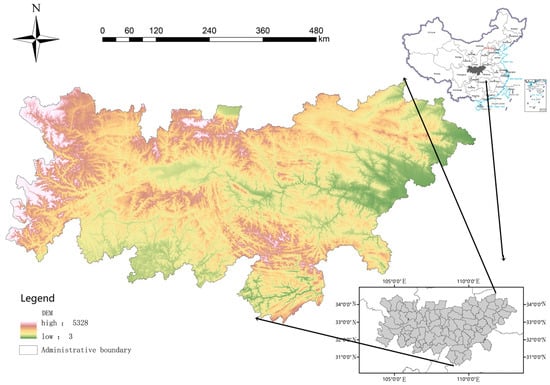
Figure 1.
Location map of the Qinling-Daba Mountains.
2.2. Data Collection
This study analyzes 224 extant state-designated traditional villages within the Qinling-Daba Mountains, documented in China’s official catalogs (1st–6th batches). It is important to note that this sample represents villages preserved to the present day and likely underrepresents historically abandoned or destroyed settlements. While this limitation may introduce a spatial bias (e.g., favoring resilient locations or later-period villages), these villages hold exceptional value as continuously inhabited cultural heritage sites. Their distribution reflects successful long-term human–environment adaptation patterns, which is a core focus of this research. The establishment periods of these settlements were ascertained through multiple sources, including the Digital Museum of Chinese Traditional Villages, local annals, and toponymic archives. In cases where there were discrepancies among different sources, the most well-supported date based on multiple lines of evidence was selected as the village founding period. The villages were classified into six distinct historical epochs: Qin to Han Dynasty, Wei-Jin–Southern–Northern Dynasties, Sui–Tang, Song–Yuan, Ming, and Qing.
In a GIS platform, historical maps of the Qinling-Daba Mountains from the Historical Atlas of China, spanning the Qin, Han, Southern–Northern Dynasties, Tang, Song, Yuan, Ming, and Qing eras, are included. To ensure accuracy, 20 evenly distributed ground control points were selected for each historical map. The georeferencing process involved adjusting the map coordinates to match the modern spatial reference system, and the average georeferencing error across all maps was calculated to be 8.2 m (root mean square error). They were georeferenced and spatially adjusted using satellite images and administrative boundary vector data from the National Geomatics Center. Period-specific base maps were created through this process. River networks, ancient cities, and historical routes were synthesized, integrated, and vectorized, with validation from archeological records, modern remote sensing imagery, and field surveys.
Village coordinates were obtained via the Baidu Maps API, with an approximate accuracy of 1–5 m. Digital Elevation Model (DEM) data, with a resolution of 30 m sourced from the Geospatial Data Cloud platform (SRTM), were retrieved. ArcGIS was utilized to generate elevation, slope, and aspect maps. ArcGIS editing tools facilitated the extraction of hydrological systems, ancient post roads, and historical urban centers from each era’s base map using point-to-point connections and retrogressive methods.
Figure 2 outlines the study’s workflow, covering data collection (Qinling-Daba historical/village data), method application (Geodetector, geographic tools), spatiotemporal analysis (settlement shifts), factor exploration (natural/human drivers), grid processing, and conclusion (dynamics, strategies, and gaps), guiding traditional village pattern research.
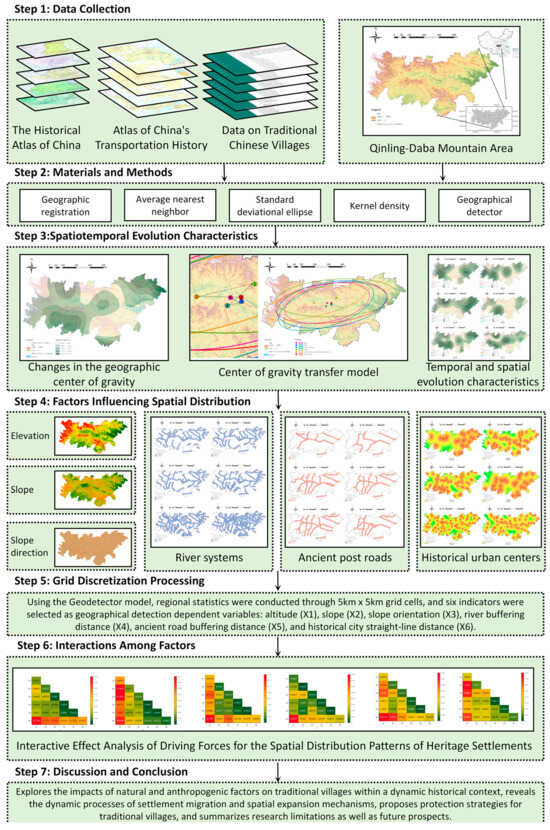
Figure 2.
Article research framework.
2.3. Research Tools and Methods
2.3.1. Average Nearest Neighbor
The Average Nearest Neighbor (ANN) analysis is employed to reflect the spatial clustering patterns of point features by comparing the actual nearest neighbor distance among features within the spatial range with the theoretical nearest neighbor distance [40]. The formula is as follows:
A is the area of the study region; n is the sample count; rE is the expected distance to the nearest neighbor; rI is the measured spatial nearest neighbor distance; R indicates the nearest neighbor index. The spatial distribution level of research samples in the area can be identified by the value of R: random distribution occurs when R equals 1, clustered distribution when R is less than 1, and dispersed distribution when R is greater than 1.
2.3.2. Standard Deviational Ellipse
The Standard Deviational Ellipse (SDE) is an effective spatial statistical method capable of precisely revealing the overall characteristics of the spatial distribution of geographic features [41]. The center of the SDE corresponds to the spatial distribution centroid of traditional village gravity centers. The major axis and minor axis represent the main and sub-trend directions of the spatial distribution of features, respectively. The lengths of the major and minor axes indicate the extent to which the feature spatial distribution deviates from the centroid in the main and sub-trend directions [42,43]. The formula is as follows:
where represents the mean center coordinates; θ stands for the azimuth angle of the ellipse; and xi, yi are the spatial coordinates of the point features.
2.3.3. Kernel Density
The Kernel Density Estimation (KDE) is a method that estimates the density of geographic features in the vicinity without assuming a specific parametric model. A kernel function is used to assign varying weights to sample points in the research area, creating a smoother density map that highlights the density characteristics of the unknown region [44]. The calculation formula is as follows:
In this context, f(x,y) represents the estimated density at the coordinates (x,y); n denotes the total number of observations; h is the bandwidth parameter; k stands for the kernel function; and di signifies the distance from a point in the study area to the i-th observation point [45].
2.3.4. Geographical Detector
The geographical detector primarily serves as an analytical tool for identifying and leveraging spatial heterogeneity. It can assess the spatial heterogeneity of individual factors and examine the coupling correlation between two factors [46,47]. The calculation formula is as follows:
The q value quantifies how well the independent variable can detect, ranging from 0 to 1. A higher q value indicates a stronger explanatory power and influence of factor x on the spatial distribution y of traditional villages. Here, h = 1, 2, … and L signifies the stratification of variable y or factor x, meaning classification or partition. represents the quantity of units in layer h, while N denotes the total number of units within the basin. signifies the variance of layer h, and stands for the variance of the y values across the basin. This approach evaluates the impact and explanatory capability of the interplay between the influencing factors and on the variable y, examining whether their interaction leads to enhancing or attenuating effects, or remains independent and unaltered.
3. Results
3.1. Spatial Distribution Pattern
Nearest neighbor distance analysis conducted via ArcGIS 10.8 revealed an observed mean distance of 15.91 km and an expected mean distance of 23.36 km, yielding an R-value of 0.68 with a 95% confidence interval (0.65–0.71). This statistical outcome indicates an aggregated spatial pattern (R < 1), which is statistically significant as shown by a z—score of −9.13 and a p-value < 0.01. These statistics confirm that the traditional villages exhibit a significantly aggregated spatial pattern rather than a random distribution.
3.2. Spatial Distribution Density
KDE in ArcGIS 10.8 identified four distinct traditional village clusters in the Qinling-Daba Mountains (Figure 3). The Hanzhong (Shaanxi)–Longnan (Gansu) cluster occupies the western mountainous terrain with valley plains along the Jialing and Han River basins. The Guangyuan–Bazhong (Sichuan) cluster lies in the northeastern Sichuan Basin foothills of the Micang Mountain, traversed by the Jialing, Nan, and Tong rivers. Ankang (Shaanxi) anchors the Han River Valley as southern Shaanxi’s agricultural and demographic core. The Sanmenxia–Luoyang (Henan) cluster spans the eastern Qinling foothills transitioning to plains, featuring the Luo, Sha, and Yi river systems.
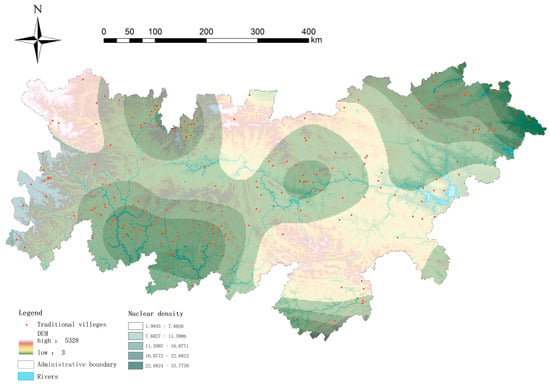
Figure 3.
Spatial Kernel Density Estimation of Heritage Settlements.
3.3. Changes in the Geographic Center of Gravity
Analysis of the traditional village centroid migration in the Qinling-Daba Mountains was conducted using Mean Center and SDE tools in ArcGIS 10.8 (Figure 4). The mean center trajectory shifted northwest-northeast-southwest, reflecting the southward relocation of politico-economic hubs, transportation/immigration policies, and watershed-oriented settlement principles. SDE parameters indicated that Qin–Han imperial road networks and Tang’s Chang’an-centric policies drove east–west clustering along the Han River, while the post-Tang An Lushan Rebellion triggered a northeastward shift toward the Hanzhong Basin. Post-Song–Yuan, the Southern Song’s military frontiers along the Jialing River and the construction of the Micang Ancient Road shortened spatial axes, followed by Ming–Qing’s ‘Huguang-filling-Sichuan’ migration policy and the Qing administrative expansion, which diffused settlements southwestward into mountainous hinterlands. This trajectory exposes how political events (e.g., imperial policies, military strategies) and ‘parallel ranges enclosing valleys’ topography synergistically shaped settlement distributions, transforming the region from a marginal zone to a socio-economic corridor.
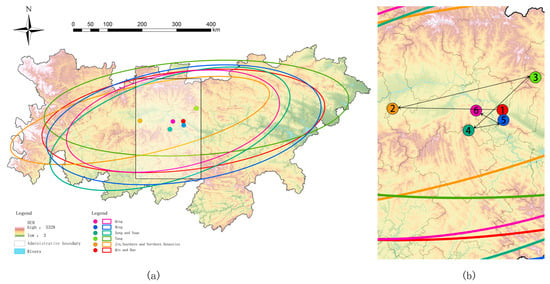
Figure 4.
Standard Deviation Ellipse Analysis of Traditional Villages across Diverse Historical Epochs. (a) Core Distribution Areas (ellipses); (b) Center Trajectory (points), the numbers 1–6 represent Qin and Han, Wei, Jin, Southern and Northern Dynasties, Sui and Tang, Song and Yuan, Ming, and Qing respectively.
3.4. Temporal and Spatial Evolution Characteristics
KDE revealed consistently clustered distribution patterns of traditional villages across six historical periods in the study area (Figure 5). The spatiotemporal trajectory demonstrates five developmental phases: emergence, diffusion, transformation, expansion, and maturation.
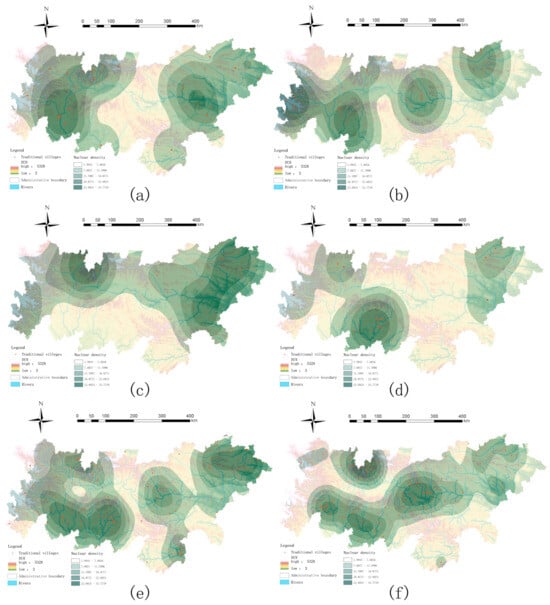
Figure 5.
Spatial Density Patterns of Heritage Settlements across Distinct Historical Eras. (a) The Qin–Han Dynastic Period; (b) Wei, Jin, and Northern and Southern Dynasties; (c) Sui and Tang Dynasties; (d) Song and Yuan Dynasties; (e) Ming Dynasty; (f) Qing Dynasty.
During the Pre-Qin to Han period (BC 1100–AD 220), 22 traditional villages emerged (9.82% of the total), marking the formative phase. These settlements were concentrated in the basin foothills across Sichuan, Gansu, and Henan, exhibiting a dual-core spatial pattern. Favorable conditions—gentle terrain, fertile soils, river access, moderate elevation, and temperate climate—supported agriculture while mitigating high-altitude cultivation challenges and lowland flood risks. Vertical resource zonation met diverse subsistence needs, with foothills offering optimal accessibility for early communities using primitive tools.
The period of the Wei, Jin, and Northern and Southern Dynasties (AD 220–589), a time of fragmentation and warfare following the collapse of the Han Dynasty, witnessed initial expansion (11 villages, 4.91%). Conflicts in northern China triggered significant southward migration and ethnic integration, driving settlement diffusion along the Hanzhong–Bashu corridor. Southern Shaanxi and northern Sichuan, combining agricultural potential with defensive advantages, saw heightened density. Villages developed around transport nodes and military–agricultural zones, reflecting intensified mountain resource exploitation during turmoil.
Sui–Tang periods (AD 581–907) brought accelerated growth (12 villages, 5.35%). Population pressure from Chang’an (the capital) stimulated the demand for resources, shaping a settlement ring around the metropolis via transportation routes. Hanzhong and Ankang (Shaanxi) thrived as tributary hubs, Guangyuan and Langzhong (Sichuan) controlled Bashu access, and Xiangyang (Hubei) anchored north–south transit. Villages combined farming with trade, some evolving into garrison forts (zhen/bao), demonstrating systematic mountain development. Following the devastating An Lushan Rebellion (AD 755–763), which severely weakened the Tang central authority, strategic shifts prompted defensive adaptations [48].
The Song–Yuan period (AD 960–1368) marked a transformative phase with 15 traditional villages (6.69%). Conflicts with the neighboring Jurchen-led Jin Dynasty (AD 1115–1234) and the subsequent Mongol Yuan conquest fundamentally shifted village functions from Sui–Tang trade-oriented models to military–agricultural complexes. Northern Sichuan, serving as a critical defensive frontier for the Southern Song regime (ruling southern China from AD 1127 after losing the north to the Jin) against both Jin and later Yuan forces, developed dense garrison forts and farming settlements. Southern Shaanxi formed defense networks under the Lizhou Road military system [49]. Agricultural innovations (e.g., terraced fields) and specialized crafts prompted functional diversification, with settlements expanding to mid-slope elevations. Scattered villages also emerged in western Henan and southeastern Gansu, facilitated by the state-managed tea–horse trade (exchanging tea for horses with Tibetan and other frontier groups) or the establishment of military stations.
The Ming Dynasty (AD 1368–1644) witnessed explosive growth (89 villages, 39.73%). Military/civilian settlement policies, legalized mountain reclamation, and Sichuan–Shaanxi trade prosperity multiplied villages in northeastern Sichuan, southern Shaanxi, and northwestern Hubei. This surge was significantly shaped by large-scale migration, primarily from the densely populated Huguang region (modern Hubei and Hunan) into the mountainous areas of Shaanxi and Sichuan. Southern Shaanxi settlements linearly aligned along the Han River tributaries, while northwestern Hubei incorporated reclamation villages into administrative systems during the Chenghua period. Villages expanded from foothills to mid-slopes, exhibiting military–agricultural–trade hybrid functions [50].
The Qing Dynasty (AD 1644–1912) represented a period of maturation (75 villages, 33.48%). The ‘Huguang-filling-Sichuan’ migration, drought-resistant crops (e.g., maize), and administrative development accelerated core-region growth. Northern Sichuan formed corridor-style clusters along the Micang Route and Jialing River, integrating farming and salt production. Southern Shaanxi developed grid-patterned agricultural/trade settlements in Han River valleys with mixed migrants. Northwestern Hubei established hierarchical village–town–fort systems along upper Han River tributaries. By Jiaqing’s reign, reclamation permeated all elevations, forging multifunctional (agricultural/commercial/military) frameworks that defined the region’s traditional village distribution [51].
3.5. Factors Influencing Spatial Distribution
The spatial distribution of traditional villages reflects multifactorial influences. Six indicators spanning natural and anthropogenic dimensions—elevation, slope gradient, aspect, river systems, ancient post roads, and distance to historical cities—were analyzed for correlation with settlement patterns, accounting for the Qinling-Daba Mountains’ environmental and historical contexts.
Elevation critically influenced settlement patterns, reflecting traditional villages’ prioritization of environmental suitability for habitation and cultivation. Based on the topographical characteristics of the research area, topography was classified into plains (<500 m), hills (500–1000 m), low mountains (1000–1500 m), and mid-high mountains (>1500 m). The 224 villages averaged 818.86 m in elevation, with 120 in hilly and 57 in mountainous zones, indicating a hill–mountain distribution orientation. Historical analysis revealed rising average elevations (Table 1): Low-elevation plains (0–500 m) maintained stable settlement proportions due to topographical and hydrological advantages, serving as enduring agricultural bases. Hills (500–1000 m) emerged as core development zones, peaking at 75% during Sui–Tang dynastic prosperity through farming convenience and defensive merits, though declining temporarily during Ming migration-driven mid-altitude expansion. Low mountains (1000–1500 m) became refuges or reclamation frontiers during the Wei–Jin conflicts (25%) and Ming migration waves (21%), reflecting how social upheavals drove vertical expansion. Mid-high mountains (>1500 m) remained marginal due to harsh climates and terrain constraints. This formed a hierarchical pattern: hills as cores, low/mid-elevations as buffer zones, and high mountains as peripheries.

Table 1.
Spatial Proportion of Heritage Settlements Classified by Distinct Geomorphic Types in Each Historical Epoch.
Slope gradient critically shapes settlement distribution, as villages typically avoid steep terrain. Based on mountain slope classification standards, gradients were categorized as flat (<3°), gentle (3–10°), moderate (10–25°), and steep (25–50°). Results indicate an average slope of 13.01° across historical villages, with 44.64% predominantly clustered on moderate slopes—reflecting the optimal balance between agricultural viability and residential safety (Table 2). During the Qin and Han dynasties, the development focused on gentle slopes of 3–10° (42%), supplemented by steep slopes of 10–25° (25%) and 25–50° (25%), reflecting the early farming dependence on terrain flatness. In the Wei, Jin, and Northern and Southern dynasties, the development of plains with <3° abruptly dropped to 0, while the proportion of 3–10° gentle slopes soared to 0.6, possibly due to wars prompting settlements to migrate to slopes with both farming and defensive advantages. During the Sui and Tang dynasties, the development of medium slopes of 10–25° reached a peak (46%). Relying on terrace technology to break through topographical constraints, the proportion of 25–50° steep slopes rebounded to 0.08. In the Song and Yuan dynasties, the 10–25° medium slopes continued to dominate (53%), and the proportion of 25–50° steep slopes increased to 13%, indicating further colonization of dangerous terrains under population pressure. As a whole, it formed a development logic of “gentle slopes as the foundation, medium slopes for expansion, and steep slopes fluctuating with the rise and fall of dynasties”, profoundly reflecting the interactive relationship between natural topographical constraints and historical and social changes.

Table 2.
Spatial Proportion of Heritage Settlements Classified by Distinct Slope Gradients across Diverse Historical Epochs.
The slope aspect influences sunlight, temperature, and precipitation, thereby affecting village establishment through living and production conditions. This study classified aspects into eight cardinal directions (N, NE, E, SE, S, SW, W, NW) based on clockwise degrees from north (0°/360°). Results reveal a pronounced sunny-slope preference among traditional villages, with south-, southeast-, and southwest-facing aspects accounting for 61.61% (Figure 6). This pattern originates from natural–human synergy: sunny slopes optimize crop growth and dwelling comfort in the Northern Hemisphere, while terrace systems enhance soil conservation for dryland farming. During Ming–Qing population surges, settlements expanded to shady and east–west slopes to alleviate land pressure. Hydraulic and architectural advancements facilitated shady-slope development by overcoming limitations like low temperatures and humidity. Economic diversification reduced agricultural dependence on aspect, prioritizing resource access and transportation—exemplified by migrants reclaiming complex terrain during the ‘Huguang-filling-Sichuan’ migration. Concurrently, soil erosion from prolonged sunny-slope use prompted shifts to lower-risk shady slopes, enabling comprehensive mountain resource utilization.
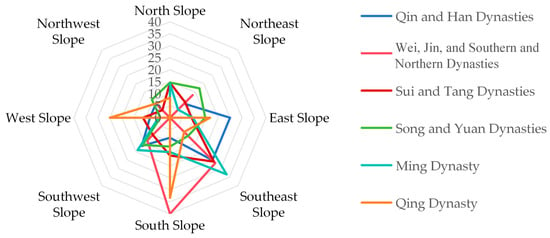
Figure 6.
Spatial Proportion of Heritage Settlements Classified by Distinct Orientation Aspects in Each Historical Epoch.
River systems provided essential water resources and transportation corridors for traditional villages, with distribution patterns closely linked to hydrological networks. Analysis revealed an average distance of 5.82 km between villages and waterways, with 90.22% of settlements located within 10 km of rivers, indicating significant hydrological dependency (Figure 7) (Table 3). Buffer analyses (5/10/15 km radii) across historical periods showed increased proximity during pre-Song–Yuan eras: settlements within 5 km rose from 31% (Qin–Han) to 53% (Song–Yuan), reflecting agricultural expansion driven by irrigation needs. Ming–Qing periods witnessed a growth in 5–15 km buffers due to: (1) migrant resettlement during the ‘Huguang-filling-Sichuan’ movement, balancing flood avoidance (Han/Jialing rivers) with water access; and (2) terrain constraints from intensified mountain reclamation (e.g., terrace systems) necessitating distant water sources. Nonetheless, proximity to waterways remained fundamental to settlement patterns.
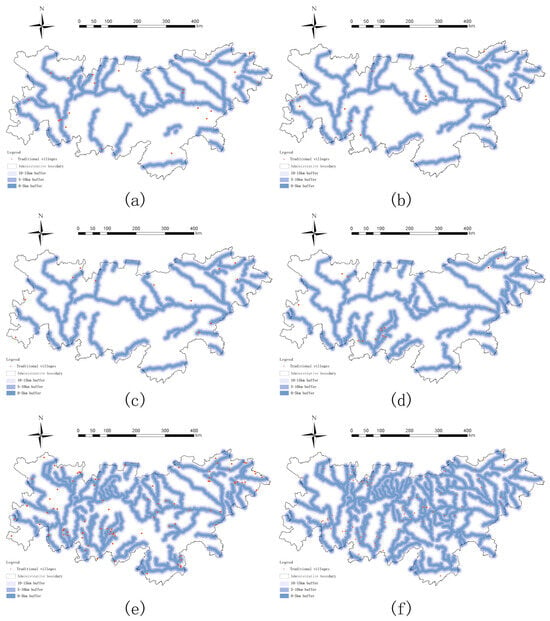
Figure 7.
Riparian Buffer Zone Spatial Analysis across Diverse Historical Epochs. (a) Qin and Han Dynasties; (b) Wei, Jin, and Northern and Southern Dynasties; (c) Sui and Tang Dynasties; (d) Song and Yuan Dynasties; (e) Ming Dynasty; (f) Qing Dynasty.

Table 3.
Spatial Proportion of Heritage Settlements Classified by Distinct Riparian Buffer Zones across Diverse Historical Epochs.
Ancient post roads served as vital arteries for political, economic, cultural, and military communication in imperial China, significantly influencing traditional village distribution. Analysis revealed an average distance of 15.88 km between villages and courier routes, with 53.33% of settlements within 20 km, demonstrating pronounced proximity to transportation networks. Buffer analyses (5/10/15 km radii) across dynastic periods indicated distinct distribution shifts (Figure 8) (Table 4): The spatial distribution of traditional villages in the Qinling-Daba Mountains across dynasties exhibited dynamic changes in relation to ancient roads. During the Qin–Han period, their proportions within <5 km, 5–10 km, and 10–20 km of roads were relatively balanced, with a slight preference for 10–20 km (22%). In the Wei–Jin–Northern and Southern Dynasties, villages within <5 km surged to 0.18 as settlements clustered near roads for defense. The Sui–Tang period saw 10–20 km areas peak at 33%, driven by the expansion of ancient road networks. The proportions of all intervals converged to around 20% during the Song–Yuan period, reflecting balanced development with mature road systems. In the Ming–Qing dynasties, the 10–20 km proportion rebounded (30% in the Qing), as population growth and agricultural reclamation drove settlements to spread along peripheral road areas. Overall, this demonstrates a historical logic of “clustering near roads-expanding along roads-peripheral diffusion”, shaped by transportation needs, social upheavals, and resource exploitation.
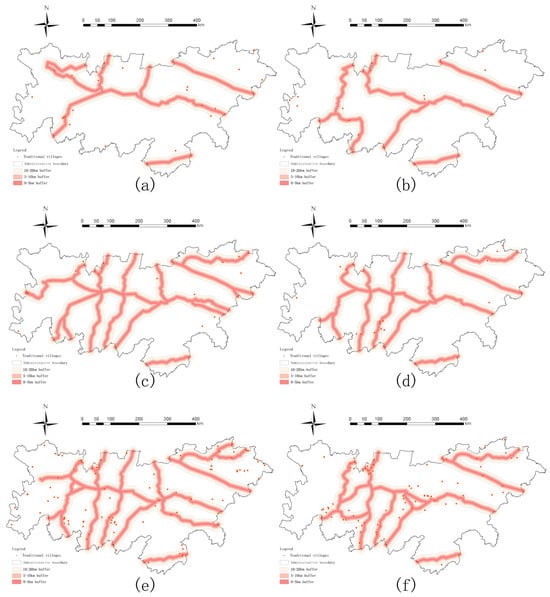
Figure 8.
Spatial Analysis of Ancient Postal Route Buffer Zones across Distinct Historical Eras. (a) The Qin–Han Dynastic Period; (b) Wei, Jin, and Northern and Southern Dynasties; (c) Sui and Tang Dynasties; (d) Song and Yuan Dynasties; (e) Ming Dynasty; (f) Qing Dynasty.

Table 4.
Spatial Proportion of Heritage Settlements Classified by Distinct Ancient Postal Route Buffer Zones across Diverse Historical Epochs.
Village-siting exhibited a direct correlation with proximity to historical urban centers—prefectural and county seats serving as political–economic hubs whose gravitational pull influenced settlement distributions. Euclidean distance analysis revealed spatiotemporal dynamics between traditional villages and ancient cities in the Qinling-Daba Mountains (Figure 9) (Table 5). During the Qin–Han period, the highest proportion (0.31) appeared in the 15–30 km zone, reflecting their reliance on urban economies and defensive advantages. In the Wei–Jin–Northern and Southern Dynasties, both 15–30 km and >60 km zones accounted for 27%, indicating settlement dispersal amid social upheavals. The Sui–Tang period saw a peak of 41% in the 30–45 km zone, driven by expanded urban influence and transportation networks. The Song–Yuan dynasties witnessed a surge to 40% in the >60 km zone in the Qinling-Daba Mountains due to population migrations and remote-area development. The Ming–Qing periods featured a resurgence in the 15–30 km zone (49% in the Ming, 56% in the Qing), as population growth and agricultural expansion drove settlements to cluster near urban markets. Overall, this demonstrates a historical logic of “proximity clustering in stable periods, distant dispersal in turbulent times,” illustrating how human settlements adapted to political–economic changes through urban–rural interactions.
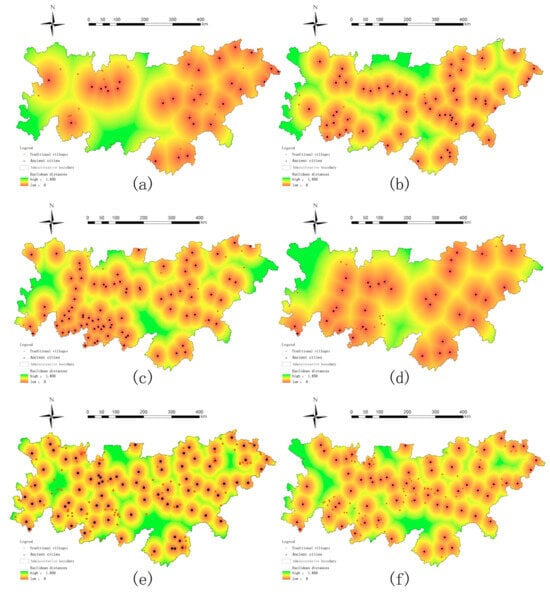
Figure 9.
Euclidean distances between traditional villages and ancient cities in each historical period. (a) Qin and Han Dynasties; (b) Wei, Jin, and Northern and Southern Dynasties; (c) Sui and Tang Dynasties; (d) Song and Yuan Dynasties; (e) Ming Dynasty; (f) Qing Dynasty.

Table 5.
Spatial Proportion of Heritage Settlements Classified by Distinct Distance Intervals.
3.6. Interactions Among Factors
The spatiotemporal differentiation patterns of traditional villages in the Qinling-Daba Mountains stem from the long-term interaction between the natural environment and human activities. In this study, we employed the geographical detector model. First, the dependent variable Y, representing the spatial distribution of traditional villages, was uniformly discretized spatially using 5 km × 5 km grids. This gridded data was then overlaid with the spatial distributions of six core independent variables X to extract the (Y, X) value combinations for each grid cell. Specifically, we selected elevation (X1), slope (X2), aspect (X3), distance to river buffers (X4), distance to ancient road buffers (X5), and distance to historical cities (X6) as explanatory factors (Figure 10).
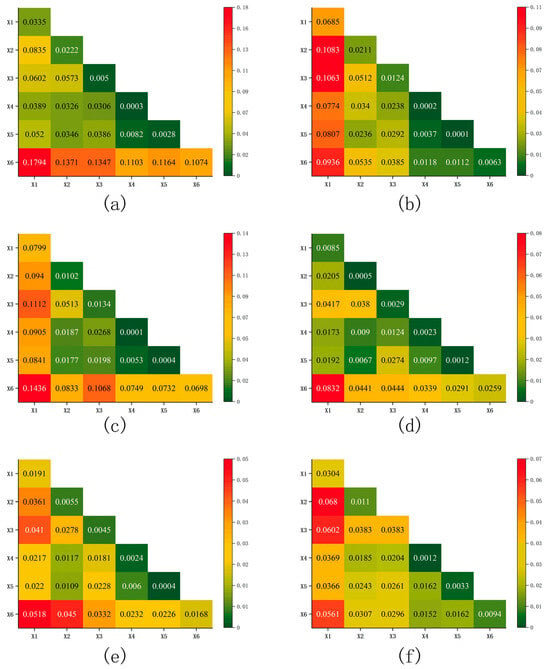
Figure 10.
Interactive Effect Analysis of Driving Forces for the Spatial Distribution Patterns of Heritage Settlements in the Qinling-Daba Mountain Region. (a) Qin and Han Dynasties; (b) Wei, Jin, and Northern and Southern Dynasties; (c) Sui and Tang Dynasties; (d) Song and Yuan Dynasties; (e) Ming Dynasty; (f) Qing Dynasty.
The Qin–Han periods demonstrated strong X1–X6 coupling (q = 0.1794), highlighting the deep integration of natural foundations and urban infrastructure. Wei–Jin–Northern and Southern Dynasties exhibited enhanced X1–X2 (q = 0.1083) and X1–X5 (q = 0.0807) interactions, reflecting terrain–transport synergies. Sui–Tang showed multidimensional natural (X1–X2/X3/X4, q = 0.07–0.09) and anthropogenic (X6–X1/X3, X5–X1, q = 0.08–0.13) couplings. Song–Yuan maintained dominant X1–X2 (q = 0.0885) and X1–X6 (q = 0.0832) synergies. Ming–Qing interactions weakened significantly (q ≤ 0.05). These low q-values imply that during the Ming–Qing dynasties, the combined influence of factors on traditional village distribution was relatively weak. This could relate to heritage vulnerability, as weaker factor interactions might mean the villages were more susceptible to external shocks (e.g., natural disasters and policy changes without strong compensatory factors). Or, in terms of resilience, it could suggest that the villages had developed self-sustaining mechanisms less dependent on the measured factor interactions.
This transition from ‘dependence coupling’ (high q-values) to ‘adaptive transformation’ (low q-values) reveals dynamic adjustments in settlement mechanisms, providing historical–geographical evidence for conservation strategies based on human–environment interaction data.
4. Discussion
This study systematically reveals the spatiotemporal evolution and driving mechanisms of traditional villages in the Qinling-Daba Mountains through a multi-method GIS-based approach integrating historical geography and spatial statistics. The research strategy centered on constructing a millennial-scale spatiotemporal database (spanning Pre-Qin to Qing dynasties) for 224 nationally recognized traditional villages, combined with multi-scale spatial analysis and factor interaction quantification via the geographical detector model. This integrated framework successfully bridged qualitative historical context with quantitative geospatial metrics, elucidating how the dynamic natural environment and socio-political factors jointly shaped the settlement patterns in this region.
The findings offer significant innovations. First, they unveil dynamic vertical zonation: beyond confirming hill–mountain preferences, the study quantifies how social upheaval (e.g., migration to low mountains as refuges during Wei–Jin conflicts) and state policies (e.g., the Ming–Qing “Huguang-filling-Sichuan” migration driving mid-slope reclamation) actively reconfigured elevation niches, challenging static environmental determinism. Geographical detector analysis quantified a fundamental shift in factor coupling: strong early “dependence coupling” (e.g., Qin–Han’s deep integration of elevation and urban proximity, q = 0.1794) weakened significantly by Ming–Qing (q ≤ 0.05), signaling a transition from environmental determinism toward societal “adaptive transformation” driven by agricultural innovations (maize and sweet potato), commercialization, and administrative maturation. Spatially, SDE and KDE vividly mapped the trajectory from linear, the trajectory from valley-confined clusters (Qin–Han–Tang) to hinterland diffusion (Ming–Qing) contrasts with the Wuling Mountains’ linear distribution along karst valleys. This progression from refuge to resource exploitation aligns with Elvin’s Southwest China highland reclamation studies, but with greater intensity due to Qinling’s role as a demographic pressure-release zone.
However, limitations merit attention. A key methodological limitation is the reliance on extant villages. Our sample likely underrepresents early or vanished settlements (e.g., Pre-Qin–Han to Sui–Tang eras), potentially skewing spatial patterns toward more resilient locations and later dynastic periods. For instance, villages in conflict-prone frontiers or ecologically fragile zones may have been abandoned and thus excluded. Key factors like cultural practices (clan migration and ethnic distribution), localized resource economies (salt wells and tea trade), and land tenure systems were not quantitatively integrated, limiting socio-cultural nuance. Temporal resolution by dynasty may mask intra-era fluctuations (e.g., mid- vs. late-Ming changes), while treating roads/cities as static within periods overlooks feedback loops with village growth.
Future work should incorporate archeological surveys and local gazetteers to expand settlement records, integrate socio-economic datasets, employ finer temporal slices where feasible, model dynamic network evolution, and conduct micro-scale case studies to unravel specific policy–technology mechanisms. Geocoding these data with spatial models would quantify relationships like clan territory boundaries and river basin settlements, addressing gaps in social mechanism analysis and temporal dynamics. Addressing these gaps will deepen understanding of long-term human–environment interactions in mountainous landscapes and strengthen the foundations for sustainable heritage conservation.
5. Conclusions
This study employs historical geography analysis, KDE, centroid migration modeling, and Geodetector techniques to decipher the 2000-year evolutionary trajectory of 224 traditional villages within the Qinling-Daba Mountains. Our findings illuminate the dynamic interplay of natural and anthropogenic forces in shaping settlement sustainability, yielding three principal insights:
- The villages exhibit a distinct mononuclear clustering pattern coexisting with multi-regional symbiosis. The evolutionary process, from the nascent Qin–Han stage to the mature Ming–Qing phase, suggests a southwestward shift in spatial centroids, primarily along hydrological and transportation corridors. This trajectory indicates millennia-long adaptive human–environment interactions.
- The q-statistic analysis reveals a significant shift in drivers: early settlement patterns were strongly coupled with natural infrastructure (q > 0.07), while later stages transitioned to human-dominated adaptation (q ≤ 0.05). During this transition, socio-political agency, manifested through agrotechnologies (e.g., terraces and drought-resistant crops) and policies (e.g., military colonies and migration initiatives), effectively overcame environmental constraints. Settlement concentration favored sunny slopes proximal to waterways (76% within 1 km), with key anthropogenic catalysts (e.g., ‘Huguang-filling-Sichuan’ migration, tea–horse trade, and Qing agricultural innovations) driving the southwestward shift. This finding quantitatively demonstrates how transitional mountainous zones reconcile environmental limitations with socio-political agency through synergistic natural-foundation and cultural-economic networks.
- Conservation strategies should prioritize the integrity of historic socio-ecological networks, such as the Han River Valley’s water-transport-settlement systems. Reactivating cultural corridors (e.g., the Micang Route) could be enhanced by digital twin technology, building on China’s “14th Five-Year Plan” initiatives for cultural heritage digitalization. Integrating traditional ecological knowledge (e.g., terrace hydrology) with modern agroecology aligns with pilot projects like the Qinling Ecological Compensation Mechanism Pilot, which could inform the establishment of ecological compensation funds.
Author Contributions
T.C.: conceptualization, methodology, software, validation, formal analysis, investigation, resources, data curation, writing—original draft preparation, writing—review and editing, visualization; C.L.: conceptualization, validation, supervision, project administration, funding acquisition, validation. All authors have read and agreed to the published version of the manuscript.
Funding
This research was funded by Social Science Research Program of the Ministry of Education of China, grant number 22YJA760045.
Data Availability Statement
The original contributions presented in this study are included in the article, and further inquiries can be directed at the corresponding author.
Acknowledgments
The figures and tables in this text were all drawn by the authors.
Conflicts of Interest
The authors declare no conflicts of interest.
References
- Wang, H.; Chiou, S. Study on the Sustainable Development of Human Settlement Space Environment in Traditional Villages. Sustainability 2019, 11, 4186. [Google Scholar] [CrossRef]
- Hu, X.; Li, H.; Zhang, X.; Chen, X.; Yuan, Y. Multi-dimensionality and the totality of rural spatial restructuring from the perspective of the rural space system: A case study of traditional villages in the ancient Huizhou region, China. Habitat. Int. 2019, 94, 102062. [Google Scholar] [CrossRef]
- Wu, C.; Chen, M.; Zhou, L.; Liang, X.; Wang, W. Identifying the Spatiotemporal Patterns of Traditional Villages in China: A Multiscale Perspective. Land 2020, 9, 449. [Google Scholar] [CrossRef]
- Zhou, M.; Chu, S.; Du, X. Safeguarding traditional villages in China: The role and challenges of Rural Heritage preservation. Built Herit. 2019, 3, 81–93. [Google Scholar] [CrossRef]
- Körl, J.G. Die Beziehungen Zwischen den Menschenverrichtungen, dem Wohnsitze und der Topographie; Justus Perthes: Gotha, Germany, 1841. [Google Scholar]
- Schultze, O. Bemerkungen zur Siedlungsgeographie; B.G. Teubner: Leipzig, Germany, 1906. [Google Scholar]
- National Traditional Village List. Available online: http://www.chuantongcunluo.com/index.php/Home/Gjml/gjml/id/24.html (accessed on 5 June 2025).
- Ma, H.; Tong, Y. Spatial differentiation of traditional villages using ArcGIS and GeoDa: A case study of Southwest China. Ecol. Inform. 2022, 68, 101416. [Google Scholar] [CrossRef]
- Zhang, Y.; Han, N.; Zhang, B.; Lu, C.; Yang, M.; Zhai, F.; Li, H. Spatial and temporal distribution characteristics and evolution of traditional villages in the Qihe River Basin of China. Sci. Rep. 2025, 15, 10077. [Google Scholar] [CrossRef]
- Nie, Z.; Chen, C.; Pan, W.; Dong, T. Exploring the Dynamic Cultural Driving Factors Underlying the Regional Spatial Pattern of Chinese Traditional Villages. Buildings 2023, 13, 3068. [Google Scholar] [CrossRef]
- Deng, Y.; Zhou, W.; Fu, X.; Yao, Y. Analysis of the evolutionary process of traditional village spatial pattern: The case of Gaoyi village in Western Hunan, China. PLoS ONE 2024, 19, e0309814. [Google Scholar] [CrossRef]
- Qin, R.J.; Leung, H.H. Becoming a Traditional Village: Heritage Protection and Livelihood Transformation of a Chinese Village. Sustainability 2021, 13, 2331. [Google Scholar] [CrossRef]
- Wang, L.; Wen, C. Traditional Villages in Forest Areas: Exploring the Spatiotemporal Dynamics of Land Use and Landscape Patterns in Enshi Prefecture, China. Forests 2021, 12, 65. [Google Scholar] [CrossRef]
- Zhou, Y.; Liu, M.; Xie, G.; Liu, C. Landscape Ecology Analysis of Traditional Villages: A Case Study of Ganjiang River Basin. Appl. Sci. 2024, 14, 929. [Google Scholar] [CrossRef]
- Liu, P.; Zeng, C.; Liu, R. Environmental adaptation of traditional Chinese settlement patterns and its landscape gene mapping. Habitat. Int. 2023, 135, 102808. [Google Scholar] [CrossRef]
- Lin, Z.; Chen, K.; Jiao, K.; Li, Z. Spatio-temporal characteristics of traditional village landscape pattern and its influencing factors from the perspective of tourism development: A case study of Huangcheng Village, China. J. Asian Archit. Build. Eng. 2025, 24, 1000–1012. [Google Scholar] [CrossRef]
- Fang, Q.; Li, Z. Cultural ecology cognition and heritage value of huizhou traditional villages. Heliyon 2022, 8, e12627. [Google Scholar] [CrossRef]
- Xu, Q.; Wang, J. Recognition of Values of Traditional Villages in Southwest China for Sustainable Development: A Case Study of Liufang Village. Sustainability 2021, 13, 7569. [Google Scholar] [CrossRef]
- Katapidi, I. Heritage policy meets community praxis: Widening conservation approaches in the traditional villages of central Greece. J. Rural Stud. 2021, 81, 47–58. [Google Scholar] [CrossRef]
- Shen, J.; Chou, R.J. Rural revitalization of Xiamei: The development experiences of integrating tea tourism with ancient village preservation. J. Rural Stud. 2022, 90, 42–52. [Google Scholar] [CrossRef]
- Zhou, Z.; Zheng, X. A Cultural Route Perspective on Rural Revitalization of Traditional Villages: A Case Study from Chishui, China. Sustainability 2022, 14, 2468. [Google Scholar] [CrossRef]
- Tang, C.; Liu, Y.; Wan, Z.; Liang, W. Evaluation system and influencing paths for the integration of culture and tourism in traditional villages. J. Geogr. Sci. 2023, 33, 2489–2510. [Google Scholar] [CrossRef]
- Bian, J.; Chen, W.; Zeng, J. Spatial Distribution Characteristics and Influencing Factors of Traditional Villages in China. Int. J. Environ. Res. Public Health 2022, 19, 4627. [Google Scholar] [CrossRef]
- Chen, Y.; Li, R. Spatial Distribution and Type Division of Traditional Villages in Zhejiang Province. Sustainability 2024, 16, 5262. [Google Scholar] [CrossRef]
- Liu, W.; Xue, Y.; Shang, C. Spatial distribution analysis and driving factors of traditional villages in Henan province: A comprehensive approach via geospatial techniques and statistical models. Herit. Sci. 2023, 11, 185. [Google Scholar] [CrossRef]
- Zheng, X.; Wu, J.; Deng, H. Spatial distribution and land use of traditional villages in southwest China. Sustainability 2021, 13, 6326. [Google Scholar] [CrossRef]
- Zhu, Q.; Liu, S. Spatial morphological characteristics and evolution of traditional villages in the mountainous area of Southwest Zhejiang. Isprs Int. J. Geo-Inf. 2023, 12, 317. [Google Scholar] [CrossRef]
- Chen, W.; Yang, L.; Wu, J.; Wu, J.; Wang, G.; Bian, J.; Liu, Z. Spatio-temporal characteristics and influencing factors of traditional villages in the Yangtze River Basin: A Geodetector model. Herit. Sci. 2023, 11, 111. [Google Scholar] [CrossRef]
- Li, T.; Li, C.; Zhang, R.; Cong, Z.; Mao, Y. Spatial heterogeneity and influence factors of traditional villages in the Wuling Mountain area, Hunan Province, China based on Multiscale Geographically Weighted Regression. Buildings 2023, 13, 294. [Google Scholar] [CrossRef]
- Gao, C.; Wu, Y.; Bian, C.; Gao, X. Spatial characteristics and influencing factors of Chinese traditional villages in eight provinces the Yellow River flows through. River Res. Appl. 2023, 39, 1255–1269. [Google Scholar] [CrossRef]
- Yan, Y.; Jing, H.; Dajun, L.; Yaoyan, J.I.A. Spatial structure identification and influence mechanism of Miao traditional villages in Guizhou Province. Econ. Geogr. 2021, 41, 232–240. [Google Scholar] [CrossRef]
- Xie, G.; Zhou, Y.; Liu, C. Spatial distribution characteristics and influencing factors of Hakka traditional villages in Fujian, Guangdong, and Jiangxi, China. Sustainability 2022, 14, 12068. [Google Scholar] [CrossRef]
- Jin, L.; Wang, Z.; Chen, X. Spatial distribution characteristics and influencing factors of traditional villages on the Tibetan Plateau in China. Int. J. Environ. Res. Public Health 2022, 19, 13170. [Google Scholar] [CrossRef]
- Xu, Y.; Yang, X.; Feng, X.; Yan, P.; Shen, Y.; Li, X. Spatial distribution and site selection adaptation mechanism of traditional villages along the Yellow River in Shanxi and Shaanxi. River Res. Appl. 2023, 39, 1270–1282. [Google Scholar] [CrossRef]
- Zhu, J.; Xu, W.; Xiao, Y.; Shi, J.; Hu, X.; Yan, B. Temporal and spatial patterns of traditional village distribution evolution in Xiangxi, China: Identifying multidimensional influential factors and conservation significance. Herit. Sci. 2023, 11, 261. [Google Scholar] [CrossRef]
- Gao, S.; Wang, J.; Liu, S.; Xu, X.; Liao, Y.; Zhang, Z.; Sun, T. Spatio-temporal evolution characteristics and influencing factors of traditional villages in the Qiantang River Basin based on historical geographic information. npj Herit. Sci. 2025, 13, 134. [Google Scholar] [CrossRef]
- National Development and Reform Commission. Qinba Mountain Area Regional Development and Poverty Alleviation Plan (2011–2020). Available online: http://www.ndrc.gov.cn/ (accessed on 5 June 2025).
- Chen, S.; Mehmood, M.S.; Liu, S.; Gao, Y. Spatial pattern and influencing factors of rural settlements in Qinling-Daba Mountains, Shaanxi Province China. Sustainability 2022, 14, 10095. [Google Scholar] [CrossRef]
- Zhang, P.; Li, J.; Zhang, Z.H. Spatial-Temporal Distribution Characteristics and Influencing Factors of Traditional Villages in Qinling-Daba Mountains. J. Hum. Settl. West China 2020, 35, 116–124. [Google Scholar] [CrossRef]
- Price, M. Mastering ArcGIS, 5th ed.; McGraw Hill Press: New York, NY, USA, 2012. [Google Scholar]
- Lefever, D. Measuring geographic concentration by means of the standard deviational ellipse. Am. J. Sociol. 1926, 32, 88–94. [Google Scholar] [CrossRef]
- Chew, V. Confidence, prediction, and tolerance regions for the multivariate normal distribution. J. Am. Stat. Assoc. 1966, 61, 605–617. [Google Scholar] [CrossRef]
- Mitchell, A. The ESRI Guide to GIS Analysis; ESRI Press: Redlands, CA, USA, 2005. [Google Scholar]
- Rosenblatt, M. Remarks on some nonparametric estimates of a density function. Ann. Math. Stat. 1956, 27, 832–837. [Google Scholar] [CrossRef]
- Davis, R.; Lii, K.; Politis, D. Remarks on Some Nonparametric Estimates of a Density Function; Springer: New York, NY, USA, 2011. [Google Scholar]
- Huang, Y.; Xue, Q. Spatio-Temporal Distribution Characteristics and Driving Factors of Traditional Villages in the Yellow River Basin. PLoS ONE 2024, 19, e0303396. [Google Scholar] [CrossRef]
- Wang, J.; Xu, C.D. Geodetector: Principle and prospective. Acta Geogr. Sin. 2017, 72, 116–134. [Google Scholar] [CrossRef]
- Tackett, N. Great Clansmen, Bureaucrats, and Local Magnates: The Structure and Circulation of the Elite in Late-Tang China. Asia Major. 2008, 21, 101–152. [Google Scholar]
- He, F.; Li, M.; Liu, H. Reconstruction of cropland area at Lu scale and its spatial-temporal characteristics in the Northern Song Dynasty. Acta Geogr. Sin. 2016, 71, 1967–1978. [Google Scholar] [CrossRef]
- Yang, G.; Fan, J.; Yang, M.; Li, Z. Research on the influence of military construction in the Ming Dynasty on the distribution characteristics of villages in Southeast Guizhou. J. Hum. Settl. West China 2024, 39, 157–164. [Google Scholar] [CrossRef]
- Wang, X.; Chen, G. The analysis of the basic types and specific characteristics of the Qinba mountain village landscape along the shu road in the late Qing dynasty based on iot. Mob. Inf. Syst. 2022, 1, 4837886. [Google Scholar] [CrossRef]
Disclaimer/Publisher’s Note: The statements, opinions and data contained in all publications are solely those of the individual author(s) and contributor(s) and not of MDPI and/or the editor(s). MDPI and/or the editor(s) disclaim responsibility for any injury to people or property resulting from any ideas, methods, instructions or products referred to in the content. |
© 2025 by the authors. Licensee MDPI, Basel, Switzerland. This article is an open access article distributed under the terms and conditions of the Creative Commons Attribution (CC BY) license (https://creativecommons.org/licenses/by/4.0/).